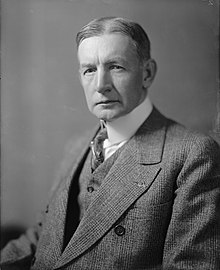Charles G. Dawes
Charles Gates Dawes (born August 27, 1865 in Marietta , Ohio , † April 23, 1951 in Evanston , Illinois ) was an American banker and politician and the founder of the Dawes Plan named after him , for which he received the Nobel Peace Prize in 1925 . From 1925 to 1929 he was Vice President of the United States .
life and work
Early years and education
Charles Dawes was a great-grandson of William Dawes , a noted War of Independence participant , and son of a brigadier general. He graduated from Marietta College in 1884 and Cincinnati Law School in 1886 . He then worked from 1887 to 1894 in Lincoln , Nebraska as a lawyer. In 1889 he married Caro Blymyer , with whom he had two children and adopted two.
Political career and career
Dawes supported the election of William McKinley as US President in 1896 and in return was appointed from 1898 as Comptroller of the Currency of the US government . In this function he was able to push through a reform of the banking system ; he also worked against the monopoly of commercial enterprises. After McKinley was murdered in 1901, Dawes retired from politics and became chairman of the board of a well-known bank in Chicago .
In 1901 he ran unsuccessfully for the US Senate in Illinois ; as a result he campaigned for social services. In 1913, he founded the R. F. Dawes Hotel for Men in Chicago , a facility for the homeless . During the First World War he served first as a major , then as a lieutenant colonel and finally as a brigadier general under General John J. Pershing in the supply chain . He was awarded the Army Distinguished Service Medal for his military service . In 1919 he left the army and in 1921 became the first director of the new budgetary authority, the Bureau of the Budget .
In 1923 Dawes was transferred to the Allied Reparations Commission , where he worked out the Dawes Plan named after him . Together with Owen D. Young he should develop a concept that should serve to ease the financial situation in Europe. With the help of this plan, Germany should be able to pay its reparations payments that were demanded after the war, and a stabilization of the German currency should be achieved. The plan was available in April 1924 and provided for financing through American bonds. This relaxed the situation and laid the foundation for the signing of the Locarno Treaties . Dawes received the Nobel Peace Prize in 1925 for his work on a program to stabilize the German economy .
In the 1924 presidential election he was the running mate of Republican Calvin Coolidge, and after his election victory on November 5, 1924, he became US Vice President for March 4, 1925. His tenure ended on March 4, 1929. From 1929 to 1932 he was the successor of Alanson B. Houghton Ambassador of the United States to the United Kingdom . He then returned to banking and was Chairman of the Board of the City National Bank and Trust Co. in Chicago until his death , where he was also buried.
Dawes as a composer
Dawes taught himself piano and composition as an autodidact . Carl Sigman wrote a text in 1951 for his composition from 1912, Melody in A Major , entitled It's All in the Game . The song was later picked up by artists such as Tommy Edwards , Van Morrison , Cliff Richard and Elton John .
literature
- Annette B. Dunlap: Charles Gates Dawes: A Life. Northwestern University Press and the Evanston History Center, Evanston 2016, ISBN 978-0-8101-3421-8 .
- Jules Witcover: The American Vice Presidency: From Irrelevance to Power. Smithsonian Books, Washington, D. C. 2014, ISBN 978-1-5883-4471-7 , pp. 279-289 (= 30. Charles G. Dawes of Illinois ).
Web links
- Information from the Nobel Foundation on the award ceremony for Charles Gates Dawes in 1925
- Charles G. Dawes in the Biographical Directory of the United States Congress (English)
- Charles G. Dawes in the Miller Center of Public Affairs of the University of Virginia (English)
- Charles G. Dawes in the database of Find a Grave (English)
- Newspaper article about Charles G. Dawes in the 20th century press kit of the ZBW - Leibniz Information Center for Economics .
Individual evidence
| personal data | |
|---|---|
| SURNAME | Dawes, Charles G. |
| ALTERNATIVE NAMES | Dawes, Charles Gates (full name) |
| BRIEF DESCRIPTION | American politician, Vice President of the USA |
| DATE OF BIRTH | August 27, 1865 |
| PLACE OF BIRTH | Marietta , Ohio |
| DATE OF DEATH | April 23, 1951 |
| Place of death | Evanston , Illinois |





